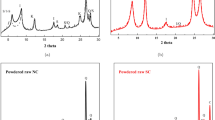Abstract
The effect of an applied pressure on the transformation of metakaolin to spinel has been studied under reactive hot-pressing conditions and the results are compared with the conventionally fired clays. For the experiments both Georgia kaolin and a Canadian fireclay (kaolinitic) were used. The results indicated that the transformation temperature of metakaolin to spinel can be lowered by the application of an external pressure, confirming the earlier work of Carruthers and Wheat. The application of Clapeyron-Clausius equation showed that in order to lower the transformation temperature, the enthalpy change (ΔH) for this transformation has to be positive, contrary to experimental DTA plots, where an exothermic reaction is generally encountered. This anomalous behaviour can be explained, if it is accepted that the exothermic peak at about 900°C in the kaolinite to mullite transformation sequence is due to the crystallization of amorphous silica, as suggested by Nicholson and Fulrath.
Résumé
Etude de l'influence de la pression exercée à chaud sur la transformation du métakaolin en spinelle et comparaison des résultats avec ceux obtenus avec les argiles calcinées de manière conventionnelle. Les expériences ont été pratiquées sur un kaolin de Géorgie et sur une argile kaolinitique du Canada. Les résultats montrent que le fait d'exercer une pression extérieure abaisse d'une manière importante la température de la transformation du métakaolin en spinelle. La variation d'enthalpie correspondante a été calculée à l'aide de l'équation de Clausius-Clapeyron. On l'a calculé positif, cependant les pics ATD montrent une réaction exothermique. On peut expliquer ce comportement anomalistique par la suggestion de Nicholson et Fulrath, selon laquelle le pic exothermique de 900° dans la transformation kaolinite/mullite est due à la cristallisation de l'oxyde de silice amorphe.
Zusammenfassung
Der Einfluß eines geeigneten Druckes auf die Umwandlung von Metakaolin in Spinell wurde unter den Bedingungen des reaktiven Warmpressens untersucht und die Resultate mit den für konventionell gebrannten Ton erhaltenen verglichen. Die Versuche erfolgten mit einem Kaolin aus Georgia und einer Tonart aus Kanada. Die Ergebnisse zeigen, daß die Übergangstemperaturen Metakaolin-Spinell durch Anwendung eines äußeren Druckes erheblich vermindert werden können. Mit Hilfe der Clausius-Clapeyronschen Gleichung wurde für die Umwandlung eine positive Enthalpieänderung errechnet, hingegen deuteten die experimentellen DTA Spitzen eine exothermische Reaktion an. Dieses anomalische Verhalten läßt sich durch die Annahme von Nicholson und Fulrath erklären, nach der die exothermische Spitze bei 900° beim Kaolinite-Mullit Übergang der Kristallisation des amorphen Siliziumdioxyds zuzuschreiben ist.
Резюме
Изучено влияние давл ения на превращение метакаолина в шпинел ь в условиях горячего реакционно го прессования и резу льтаты сравнены с данными, по лученными для случая обычных обожж енных глин. Экспериме нты проведены с каолином из Георгии и огнеупорной глиной и з Канады. Результаты п оказали, что температуру превращ ения метакаолина в шпинел ь можно значительно у меньшить использованием внеш него давления. Положитель ное изменение энталь пии (+ΔH) рассчитано для перех ода метакаолина в шпинель по уравнени ю Клапейрона-Клаузиу са.
Similar content being viewed by others
References
A. C. D. Chaklader, Nature, 206 (1965) 392.
A. C. D. Chaklader andL. G. McKenzie, Bull. Am. Ceram. Soc., 43 (1964) 892.
A. C. D. Chaklader andR. C. Cock, Bull. Am. Ceram. Soc., 47 (1968) 712.
T. G. Carruthers andB. Scott, Trans. Brit. Ceram. Soc., 67 (1968) 185.
P. E. D. Morgan andE. Scala, Sintering and Related Phenomena, Eds. G. C. Kuczynski, N. A. Hooton and C. F. Gibbon, Gordon and Breach, New York, 1967, p. 861.
G. R. Blair andA. C. D. Chaklader, Defence Research Board of Canada Report, The University of British Columbia, Vancouver, 1970.
G. W. Brindley andK. Robinson, Mining Mag., 27 (1946) 242.
G. W. Brindley andM. Nakahira, J. Am. Ceram. Soc., I, 42 (1959) 311, II, ibid. 42 (1959) 314, III, ibid. 42 (1952) 319.
R. Roy, D. M. Roy andE. E. Francis, J. Am. Ceram. Soc., 38 (1955) 198.
T. G. Carruthers andT. A. Wheat, Proc. Brit. Ceram. Soc., 3 (1965) 259.
T. A. Wheat, Ph. D. Thesis, University of Leeds, U. K. 1967.
F. W. Meer, Sprechsaal, 73 (1940) 70.
W. M. Cohn, J. Am. Ceram. Soc., 11 (1928) 296.
A. E. MacGee, J. Am. Ceram. Soc., 10 (1927) 561.
G. Sabatier, Bull. Soc Franc. Miner., 77 (1954) 935, 1077.
F. Vaughan, Trans. Brit. Ceram. Soc., 57 (1958) 38.
H. W. Van der Marel, Am. Mineral., 41 (1956) 222.
P. S. Nicholson andR. M. Fulrath, J. Am. Ceram Soc., 53 (1970) 237.
F. Freund, Ber. Dtsch. Keram. Ges., 44 (1967) 5.
K. Range, J. Russow, G. Oehlinger andA. Weiss, Ber. Dtsch. Keram. Ges., 47 (1970) 545.
B. S. Shvetsov andKh. O. Gevorkyan, J. Appl. Chem. U.S.S.R. 15 (1942) 302.,
R. E. Grim andW. F. Bradley, Am. Mineral., 33 (1948) 50.
H. D. Glass, Am. Mineral., 39 (1954) 193.
R. C. MacKenzie, Differential Thermal Investigation of Clays, Min. Soc., London, 1957, p. 106.
Author information
Authors and Affiliations
Additional information
Thanks are due to Dr. D. Coates for his helpful suggestions on the applicability of the Clapeyron-Clausius equation in this transformation sequence.
Rights and permissions
About this article
Cite this article
Blair, G.R., Chaklader, A.C.D. Kaolinite-mullite series: Firing vs. reactive hot-pressing. Journal of Thermal Analysis 4, 311–322 (1972). https://doi.org/10.1007/BF01911693
Received:
Revised:
Issue Date:
DOI: https://doi.org/10.1007/BF01911693




